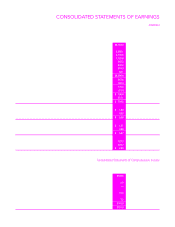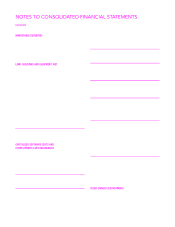Red Lobster 2015 Annual Report Download - page 37
Download and view the complete annual report
Please find page 37 of the 2015 Red Lobster annual report below. You can navigate through the pages in the report by either clicking on the pages listed below, or by using the keyword search tool below to find specific information within the annual report.
DARDEN RESTAURANTS, INC. | 2015 ANNUAL REPORT 33
NOTES TO CONSOLIDATED FINANCIAL STATEMENTS
DARDEN
LIQUOR LICENSES
The costs of obtaining non-transferable liquor licenses that are directly
issued by local government agencies for nominal fees are expensed as
incurred. The costs of purchasing transferable liquor licenses through open
markets in jurisdictions with a limited number of authorized liquor licenses
are capitalized as indefinite-lived intangible assets and included in other
assets. Liquor licenses are reviewed for impairment whenever events or
changes in circumstances indicate that the carrying amount may not be
recoverable. Annual liquor license renewal fees are expensed over the
renewal term.
GOODWILL AND TRADEMARKS
We review our goodwill and trademarks for impairment annually, as of the first
day of our fourth fiscal quarter or more frequently if indicators of impairment
exist. Goodwill and trademarks are not subject to amortization and have been
assigned to reporting units for purposes of impairment testing. The reporting
units are our restaurant brands. Our goodwill and trademark balances are
allocated as follows:
May 31, May 25,
(in millions)
2015 2014
Goodwill:
The Capital Grille $401.7 $401.7
LongHorn Steakhouse 49.3 49.4
Olive Garden (1) 30.2 30.2
Eddie V’s 22.0 22.0
Yard House 369.2 369.2
Total Goodwill $872.4 $872.5
Trademarks:
The Capital Grille $147.0 $147.0
LongHorn Steakhouse 307.8 307.8
Eddie V’s 10.5 10.5
Yard House 109.3 109.3
Total Trademarks $574.6 $574.6
(1) Goodwill related to Olive Garden is associated with the RARE Hospitality International, Inc. (RARE)
acquisition and the direct benefits derived by Olive Garden as a result of the RARE acquisition.
A significant amount of judgment is involved in determining if an indicator
of impairment has occurred. Such indicators may include, among others: a
significant decline in our expected future cash flows; a sustained, significant
decline in our stock price and market capitalization; a significant adverse
change in legal factors or in the business climate; unanticipated competition;
the testing for recoverability of a significant asset group within a reporting unit;
and slower growth rates. Any adverse change in these factors could have
a significant impact on the recoverability of these assets and could have a
material impact on our consolidated financial statements.
The goodwill impairment test involves a two-step process. The first step
is a comparison of each reporting unit’s fair value to its carrying value. We
estimate fair value using the best information available, including market
information and discounted cash flow projections (also referred to as the
income approach). The income approach uses a reporting unit’s projection
of estimated operating results and cash flows that is discounted using a
weighted-average cost of capital that reflects current market conditions.
The projection uses management’s best estimates of economic and market
conditions over the projected period including growth rates in sales, costs and
number of units, estimates of future expected changes in operating margins
and cash expenditures. Other significant estimates and assumptions include
terminal value growth rates, future estimates of capital expenditures and
changes in future working capital requirements. We validate our estimates of
fair value under the income approach by comparing the values to fair value
estimates using a market approach. A market approach estimates fair value
by applying cash flow and sales multiples to the reporting unit’s operating
performance. The multiples are derived from comparable publicly traded
companies with similar operating and investment characteristics of the reporting
units. If the fair value of the reporting unit is higher than its carrying value,
goodwill is deemed not to be impaired, and no further testing is required. If
the carrying value of the reporting unit is higher than its fair value, there is an
indication that impairment may exist and the second step must be performed
to measure the amount of impairment loss. The amount of impairment is
determined by comparing the implied fair value of reporting unit goodwill to
the carrying value of the goodwill in the same manner as if the reporting unit
was being acquired in a business combination. Specifically, fair value is
allocated to all of the assets and liabilities of the reporting unit, including
any unrecognized intangible assets, in a hypothetical analysis that would
calculate the implied fair value of goodwill. If the implied fair value of good-
will is less than the recorded goodwill, we would record an impairment loss
for the difference.
Consistent with our accounting policy for goodwill and trademarks we
performed our annual impairment test of our goodwill and trademarks as of
the first day of our fiscal 2015 fourth quarter. As of the beginning of our fiscal
fourth quarter, we had seven reporting units, five of which had goodwill: Olive
Garden, LongHorn Steakhouse, The Capital Grille, Eddie V’s and Yard House. As
part of our process for performing the step one impairment test of goodwill, we
estimated the fair value of our reporting units utilizing the income and market
approaches described above to derive an enterprise value of the Company. We
reconciled the enterprise value to our overall estimated market capitalization.
The estimated market capitalization considers recent trends in our market
capitalization and an expected control premium, based on comparable recent
and historical transactions. Based on the results of the step one impairment
test, no impairment of goodwill was indicated for any of our brands.
The fair value of trademarks are estimated and compared to the carrying
value. We estimate the fair value of trademarks using the relief-from-royalty
method, which requires assumptions related to projected sales from our
annual long-range plan; assumed royalty rates that could be payable if we
did not own the trademarks; and a discount rate. We recognize an impairment
loss when the estimated fair value of the trademarks is less than carrying
value. We completed our impairment test and concluded as of the date of the
test, there was no impairment of the trademarks for LongHorn Steakhouse,
The Capital Grille, Eddie V’s and Yard House.
We determined that there was no goodwill or trademark impairment
as of the first day of our fourth fiscal quarter and no additional indicators of
impairment were identified through the end of our fourth fiscal quarter that
would require us to test further for impairment. However, declines in our
market capitalization (reflected in our stock price) as well as in the market
capitalization of other companies in the restaurant industry, declines in sales
at our restaurants, and significant adverse changes in the operating environ-
ment for the restaurant industry may result in future impairment.
























